| |
PARADISE ON EARTH
In order to create a private retreat near the Forbidden City but away from its formality, the Kangxi emperor created a villa with gardens to the northwest of Beijing which was named the Garden of Joyful Spring (Changchunyuan 暢春園). The emperor had taken frequent excursions to this area at the foot of the Western Hills, which had abundant steams and lakes and enjoyed cool breezes. Members of the royal family often joined him and official business was sometimes conducted. A Russian embassy to Beijing in 1720 was cordially received and entertained there by the Kangxi emperor (described by John Bell, an English physician who accompanied it). [4]
In 1709 Kangxi began the construction of another estate for his fourth son, Prince Yinzhen, the future Yongzheng emperor. Just a half mile to the north, these gardens were named the Yuanmingyuan—literally, the round (yuan 園) and bright (ming 明) garden (yuan 園)—or the Garden of Perfect Brightness. When he became emperor, Yongzheng expanded this complex and made it his main residence, while leaving the Garden of Joyful Spring for his mother’s residence. He was sensitive to potential criticism of extravagance and considered himself to be frugal in his building projects.
Having been born and raised there, Yongzheng’s son the Qianlong emperor was far more dedicated to the expansion of Yuanmingyuan’s pavilions, buildings, and vistas. In 1749, a new garden named the Garden of Eternal Spring (Changchunyuan 長春園) was added to the east, built according to designs made under the emperor’s close supervision. Because he intended this to be his residence after retiring, the structures, waterways, and views were intended for pleasure more than for formal responsibilities. [5]
In 1774, Qianlong added a third garden to the entire complex, the Garden of Elegant Spring (Qichunyuan 綺春園). His son, the Jiaqing emperor (r. 1796 to 1820) added a great deal to this garden, including pavilions, bridges, lakes, and islets. When Jiaqing died in 1820, his son the Daoguang emperor (r. 1821 to 1850) maintained the tradition of garden-building. His mother and other women were moved from the Joyful Spring Garden that Kangxi had built before the Yuanmingyuan to the Elegant Spring Garden. Thereafter the former fell into disuse, while the three other gardens together became known as the Yuanmingyuan.
|
|
| |
Mapping the Yuanmingyuan

Proximity to
the Forbidden City
|
|
| |
The imperial rural retreat, Yuanmingyuan, was situated about 9.3 kilometers (5.8 miles) from the northwest gate (Xizhimen) of Beijing’s city wall. It was another 6.4 kilometers (4 miles) from the gate to the Forbidden City.
|
|
| |
The gardens of the Yuanmingyuan |
|
| |
Yuanmingyuan 圓明園
(Garden of Perfect Brightness) |
Xiyanglou 西洋楼
(European Palaces) |
Changchunyuan 長春園
(Garden of Eternal Spring) |
| |
Main Entrance |
|
Qichunyuan 綺春園
(Garden of Elegant Spring) |
| |
The gardens collectively known as the Yuanmingyuan are shown here as they would have looked around 1860 during the reign of Emperor Xianfeng.
|
|
| |
“40 Scenes” within the Yuanmingyuan |
|
| |
40 buildings within the original Yuanmingyuan were depicted in a mid-18th century album of views painted on silk. See the splendor of the grounds through these scenes, in the next chapter and in the interactive map.
|
|
| |
Although only an occasional retreat for the Kangxi emperor, the Yuanmingyuan served as the principal residence of the Yongzheng emperor. From the third year of his reign, he resided and held court there from the first lunar month until the ninth (roughly February to October). He went to the Forbidden City only when necessary for ceremonial duties, and during the winter months. Unlike his father, Yongzheng did not follow the practice of going to Chengde in the summer or autumn.
Although he contributed the most to the expansion of the Yuanmingyuan and loved to be there, the Qianlong emperor also liked to tour other locations and travel to Chengde in the fall. His stays at the Yuanmingyuan ranged from a mere 10 days in a year to as many as 251, averaging out to 127 days annually. He stayed at the Forbidden City about an equal number of days each year. In general he preferred the Yuanmingyuan from the first to the ninth lunar months, and the Forbidden City in the winter months. In the fall he also went to Chengde to hunt. [6]
The next three emperors spent relatively more time at the Yuanmingyuan. Jiaqing usually spent more days there than at the Forbidden City. The Daoguang emperor, beset with many problems of state, spent most of his time there, averaging only three months a year at the Forbidden City. He did not return to the Forbidden City until the 11th lunar month of the year. The last emperor to live there, the hapless Xianfeng (r. 1851 to 1861), spent virtually all his later years at Yuanmingyuan until it was destroyed in 1860.
Paintings of activities within the Yuanmingyuan convey a sense of the intensely private and personal nature of this imperial space. Although it grew in size and complexity, its function was to provide elegant and intimate pleasure to the emperor. Thus, in one painting, for example, we see the Yongzheng emperor depicted in his library perusing a book. |
|
  In contrast to formal court portraits, the emperor is posed casually, with his robes draped languidly and feet resting on a brazier. Near him are a tea pot, cups, and a lacquer box probably holding some tasty snacks. Although the artist is unknown, the painting was in all likelihood done by one of the Jesuit painters who regularly visited the Yuanmingyuan. The perspective and pose were Western artistic conventions with no precedent in traditional Chinese portraiture. In contrast to formal court portraits, the emperor is posed casually, with his robes draped languidly and feet resting on a brazier. Near him are a tea pot, cups, and a lacquer box probably holding some tasty snacks. Although the artist is unknown, the painting was in all likelihood done by one of the Jesuit painters who regularly visited the Yuanmingyuan. The perspective and pose were Western artistic conventions with no precedent in traditional Chinese portraiture. |
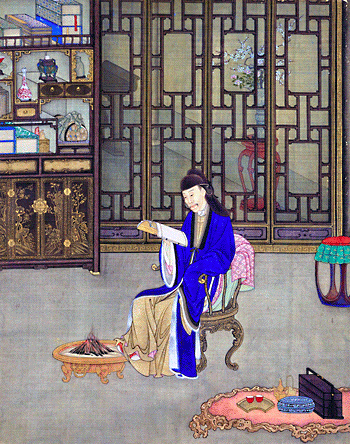 |
  Emperor Yongzheng in his library at the Yuanmingyuan Emperor Yongzheng in his library at the Yuanmingyuan
The Palace Museum, Beijing
[ymy3009]
|
| |
In another painting the Qianlong emperor is depicted as a family man, surrounded by children and a few court ladies or servants. He is still a young man—the painting dates from the beginning of his reign—but definitely the paterfamilias. The emperor faces the painter, as someone today faces a photographer, but the children are shown playing and not posed. The setting is intimate—a small pavilion in a garden. Outside the moon gate entrance is a bamboo grove in the snow; in the foreground are a pine and blossoming plum tree. These three together symbolize the winter season because they are strong and vital even in cold weather. The style of the painting, however, is again Western—in this case done by Giuseppe Castiglione, a Jesuit who was the court painter for Qianlong and worked at the Yuanmingyuan for many years.
|
|
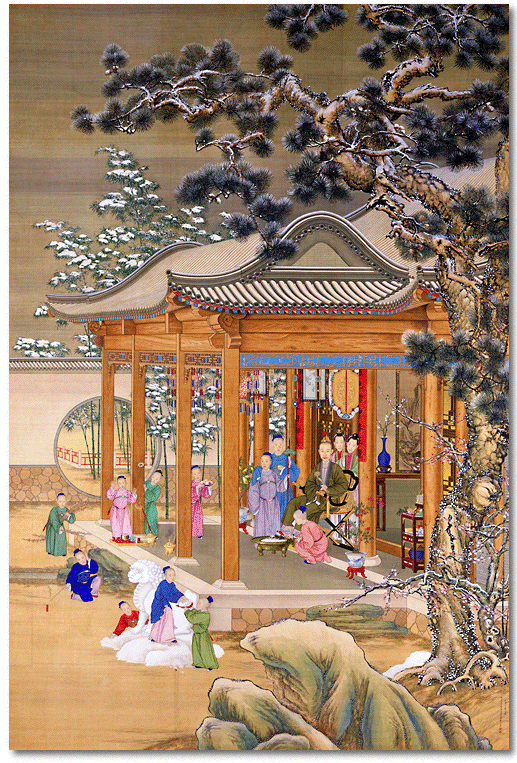 |
| |
The Qianlong emperor surrounded by children and a few court ladies or servants at the Yuanmingyuan on New Year’s Eve. Although this painting incorporates many traditional Chinese motifs, it was done in 1738 by Giuseppe Castiglione, a Jesuit who served as a court artist for Qianlong.
The Palace Museum, Beijing
[ymy3010]
|
|
| |
The idealized world of adults engaged in social activities and happy children at play in a beautiful setting is typically depicted in a set of paintings entitled “The 12 Months.” In the painting of the fourth month court ladies and gentlemen are enjoying the lake and viewing the peonies and magnolias from various terraces and pavilions. In the painting of the twelfth month, children are playing with the snow, while adults socialize, watch deer, or go sledding. While not literally based on a setting within the Yuanmingyuan, the paintings evoke the ideal vision that the emperors imagined for themselves. These two paintings, as well as several imperial portraits, all show the influence of Western linear perspective, something introduced by the Jesuits. European influence can also be seen in the architecture of the building and gate at the left of the twelfth-month painting.
|
|
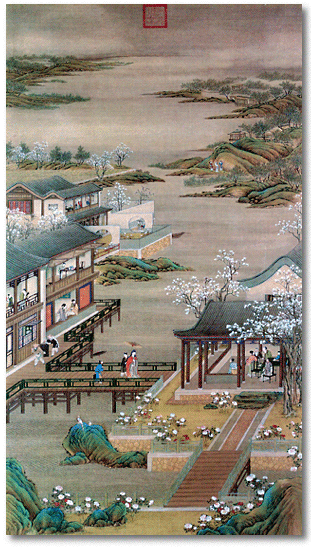 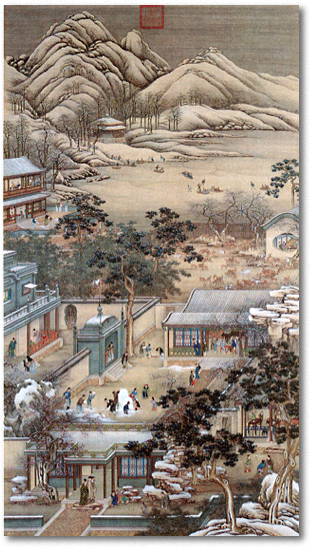 |
| |
Though not set at the Yuanmingyuan, the fourth month (left) and twelfth month (right) from a set of paintings collectively titled “The 12 Months” evoke the idealized world that the emperors aspired to in their design of the “Garden of Perfect Brightness.” Sumptuous man-made structures rest harmoniously in settings of surpassing natural beauty, while adults and children socialize and engage in genteel activities.
The National Palace Museum, Taipei
[ymy7001] [ymy7006]
|
|
| |
As in the Forbidden City, the emperor was in effect the only adult male resident in the Yuanmingyuan. Adult princes, noblemen, and high-ranking officials visited only on particular occasions and never lived there. In addition to the emperor himself, only the imperial wives, ladies, and servant girls; imperial children; and eunuchs resided at the Yuanmingyuan. The Jesuit Jean Attiret wrote:
There is but one Man here; and that is the emperor. All pleasures are made for him alone. This charming Place is scarce ever seen by any body but himself, his Women, and his Eunuchs. The Princes, and the other chief Men of the Country, are rarely admitted any farther than the Audience-Chambers. [7]
The women at the Yuanmingyuan led a life of great leisure, and their own beauty was enhanced by the beauty of the natural (or not so natural) scenery and the charming buildings. When he was still a prince, the Yongzheng emperor commissioned a set of paintings of “12 Beauties at Leisure,” each depicting a graceful, beautifully posed, and gorgeously clothed and coiffed woman. The interior settings were surely meant to depict the Yuanmingyuan, for that is where the prince resided when he had these paintings rendered.
|
|
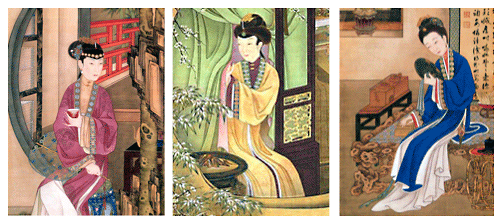 |
| |
Three of the “12 Beauties at Leisure,” a set of paintings commissioned by the Yongzheng emperor when he was still a prince. They decorated a study within his private quarters at the Yuanmingyuan.
The Palace Museum, Beijing
[ymy7007] [ymy7008a] [ymy7008]
|
|
| |
The eunuchs at the Yuanmingyuan performed important roles in the life in the gardens, as well as escorting the emperor during his travels and serving as bodyguards. Their numbers increased and reached over 500 by the end of the Qianlong reign. At the Yuanmingyuan eunuchs, like their master and the court women, enjoyed a relative informality—even familiarity—compared with the formality of the Forbidden City. Although the Qing emperors mostly succeeded in keeping eunuchs out of politics, some eunuchs did acquire wealth and considerable influence at the court and the Yuanmingyuan. [8]
In addition to these privileged members of the court, there were a handful of Jesuit missionaries who had special access to the emperors. Jesuit and other Catholic missionaries had first gone to China in the 16th century, and by the early-17th century some were welcome at the late Ming court and later at the Qing court. The emperor Kangxi greatly valued their knowledge of astronomy, mathematics, geography, and other scientific matters. Although there was an official ban on proselytizing imposed in the 1720s, some Jesuits were still retained at the court for their knowledge of the outside world. The Qianlong emperor particularly valued their skill in painting. He had them paint numerous portraits and large-scale paintings commemorating famous battles, hunting and archery at Chengde, and other activities. At the Yuanmingyuan they were asked to paint the interiors of buildings, to help design the European-style buildings later introduced to one small section of the gardens, and to keep painting portraits and domestic scenes. Attiret, the French Jesuit, wrote that among Europeans only clock-makers and painters were privileged to see the Yuanmingyuan at all. (Other missionaries, he said, spent 20 to 30 years in China without ever seeing the inside of any palace.)
|
|
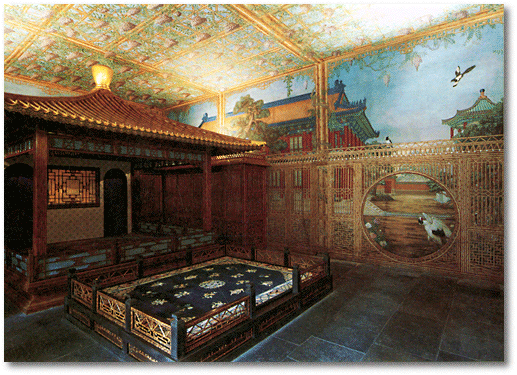 |
| |
The ornate decoration and wall paintings in this recently reconstructed room in the Forbidden City were done by Jesuit artists and resembled trompe-l'oeil murals they had painted in some of the interiors at the Yuanmingyuan.
The Palace Museum, Beijing
[ymy7002]
|
|
| |
Although the buildings of the Yuanmingyuan were totally burned to the ground in 1860, it is possible to get a sense of the ornate interior decoration provided by the Jesuits by looking at the recent reconstruction of the Juanqinzhai (“Studio of Exhaustion from Diligent Service”) within the Forbidden City. This compound of buildings was built for the Qianlong emperor as his eventual retirement residence, and he commissioned the Jesuit artists to paint murals with trompe l'oeil schemes similar to those they had created at the Yuanmingyuan. Although the buildings and overall aesthetic sensibility there was traditionally Chinese, the decoration and the visual depiction of at least some interiors were distinctly of Western inspiration.
|
|
|







